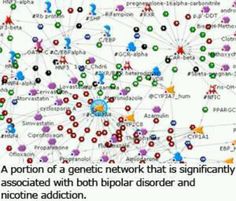Introduction:
Bipolar disorder, a mental health condition characterized by extreme mood swings, presents a complex and challenging landscape for both individuals experiencing it and the professionals dedicated to understanding and treating it. Concepts map about bipolar disorder One valuable tool that aids in comprehending. So, the multifaceted nature of bipolar disorder is the concept map. In this article, we’ll delve into the creation and application of concept maps as a means to navigate the intricate web of concepts surrounding bipolar disorder.
Understanding Bipolar Disorder:
Concepts map about bipolar disorder, it’s crucial to have a basic understanding of bipolar disorder. This mental health condition involves extreme mood swings, cycling between periods of mania and depression. The severity and duration of these mood episodes can vary, making bipolar disorder a spectrum of disorders rather than a singular entity. Factors such as genetics, brain structure, and environmental influences contribute to the development and manifestation of bipolar disorder.
Creating a Concept Map:
A concept map is a visual representation of the relationships between concepts, offering a structured way to organize and understand complex information. In the context of bipolar disorder, a concept map can help depict the interconnected nature of its various aspects, including symptoms, risk factors, treatment options, and societal implications.
-
Central Node: Bipolar Disorder
- Begin the concept map by placing “bipolar disorder” at the center. This serves as the focal point from which other concepts will branch out.
-
Symptoms: Mania and Depression
- Branch out to two main nodes representing “Mania” and “Depression.” These nodes can further extend to include specific symptoms associated with each mood state, such as elevated mood, impulsivity, or fatigue.
-
Risk Factors
- Explore the factors that contribute to the development of bipolar disorder. This can include genetic predisposition, neurotransmitter imbalances, and environmental triggers.
-
Types of Bipolar Disorder
- Create branches representing different types of bipolar disorder, such as Bipolar I, Bipolar II, Cyclothymic Disorder, and others. Each type can have its distinctive features and diagnostic criteria.
-
Treatment Options
- Include nodes for various treatment approaches, such as medication, psychotherapy, and lifestyle interventions. Connect these nodes to specific symptoms or mood states they aim to address.
-
Impact on Daily Life
- Illustrate how bipolar disorder can affect various aspects of daily life, including relationships, work, and overall quality of life.
- Prevalence and Stigma
- Explore the prevalence of bipolar disorder and the societal stigma associated with mental health conditions. Highlight the importance of raising awareness and reducing stigma for improved understanding and support.
Application and Benefits:
The concept map provides a holistic view of bipolar disorder, allowing individuals, caregivers, and professionals to better comprehend its complexities. It can be utilized in educational settings to facilitate learning, in clinical settings to aid in treatment planning, and by individuals living with bipolar disorder to enhance self-awareness.
Conclusion:
Bipolar disorder is a nuanced and challenging mental health condition that requires a comprehensive understanding. Concept mapping serves as a valuable tool to navigate the intricate web of concepts associated with bipolar disorder, providing a visual representation of its symptoms, causes, and treatments. By embracing this approach, we can foster a deeper understanding of bipolar disorder and promote more effective support and intervention strategies for those affected by this complex condition.

